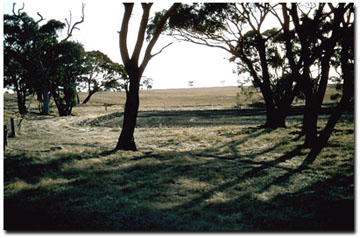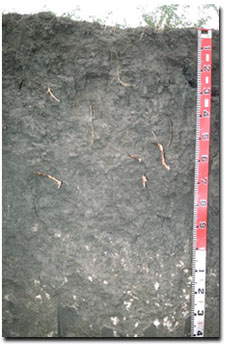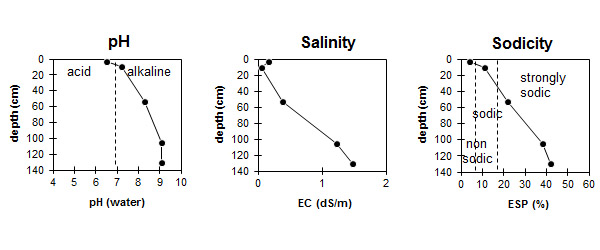LS3
Location: Kinimakatka
Australian Soil Classification: Epicalcareous-Epihypersodic, Self-mulching, Grey VERTOSOL
Northcote Factual Key: Ug 5.2
Great Soil Group: grey clay
General Landscape Description: Level to gently undulating clay plain between north-south trending rises. Gilgai microrelief is apparent.
Native Vegetation: Black Box (E. largiflorens) occurs in undisturbed areas.
 LS3 Landscape |
Soil Profile Morphology:
Surface Soil
| A1 | 0-5 cm | Dark grey (10YR4/1); medium clay; strong subangular blocky structure; very firm consistence dry; surface cracking occurs when dry; pH 6.5; abrupt and irregular change to: |  LS3 Profile |
| Note: patches of bleached fine sandy light clay (pH 7.2) can occur below the surface horizon. | |||
| Subsoil | |||
| B21 | 5-90 cm | Grey (10YR5/1); heavy clay; strong coarse prismatic, parting to strong coarse blocky structure (becoming strong fine blocky with depth); strong consistence dry; contains very few (1 %) ironstone gravel; pH 8.3; gradual change to: | |
| B22k | 90-140 cm | Light olive grey (5Y6/2); medium heavy clay; strong coarse blocky, parting to strong fine to medium blocky structure; contains few (5 %) soft and hard calcium carbonate nodules; pH 9.1. | |
- Clay texture throughout profile.
- Strong cracking when dry.
- Self-mulching surface soil.
Soil Profile Characteristics:
| - | pH | Salinity | ||
Surface (A1 horizon) | Slightly Acid | Very low | Non-Sodic | None1 |
Subsoil (B21 horizon) | Moderately Alkaline | Low | Strongly Sodic | Moderate |
Deeper Subsoil (at 1 metre) | Very Strongly Alkaline | High | Strongly Sodic | Strong |

| The surface soil is slightly acid. The subsoil is moderately alkaline becoming very strongly alkaline with depth. | The salinity rating is very low in the surface and low in the upper subsoil becoming high with depth. | The surface is non-sodic. The subsoil is strongly sodic. |
Note: The relatively low surface pH reading will not be representative of the paddock, as the site is on a relatively undisturbed fence line.
Chemical and Physical Analysis:
Horizon | Horizon Depth (cm) | pH (water) | pH (CaCl2) | EC dS/m | Sodium Chloride % | Exchangeable Cations | |||
Ca | Mg | K | Na | ||||||
meq/100g | |||||||||
A1 | 0-10 | 6.5 | 5.7 | 0.16 | 15.5 | 6.4 | 1.3 | 0.9 | |
A2 | 10-15 | 7.2 | 5.8 | 0.06 | 6.6 | 2.8 | 0.3 | 1.1 | |
B21 | 15-35 | 8.3 | 7.2 | 0.39 | 13.2 | 8.8 | 1.7 | 6.6 | |
B22k | 35-70 | 9.1 | 8.6 | 1.23 | 0.24 | 7.5 | 11.5 | 2 | 12.4 |
B23 | 70-100 | 9.1 | 8.9 | 1.47 | 0.3 | 7.5 | 14 | 2.2 | 16.6 |
Horizon | Horizon Depth (cm) | Total Nitrogen % | Oxidisable Organic Carbon % | Field Capacity pF2.5 | Wilting Point pF4.2 |
A1 | 0-10 | 0.25 | 3 | 31.2 | 19 |
A2 | 10-15 | 0.06 | 1.2 | 19.2 | 7.9 |
B21 | 15-35 | 43.5 | 20.9 | ||
B22k | 35-70 | ||||
B23 | 70-100 |
Management Considerations:
Surface (A) horizon
- The surface horizon is non-sodic and does not disperse. However, dispersion may occur after mechanical shearing during cultivation or by stock trampling when wet (as indicated by strong dispersion after remoulding).
- Tillage or excessive trafficking of clay soils should be avoided if the soil is in a moist to wet condition (ie. wetter than the plastic limit) At such moisture conditions, tillage or excessive trafficking can result in structural damage (eg. compaction, smearing) occurring. Ideally, tillage and trafficking should take place when the soil is drier than the plastic limit down to at least the tillage depth.
- The surface horizon has a relatively high level of nitrogen and organic carbon, which reflects the site occurring in an uncultivated paddock edge. The inherent fertility of the surface soil (based on the sum of the exchangeable basic cations) is high.
- Due to its clay texture the surface horizon has a reasonably high wilting point which means that plants will not be able to fully utilise light rains falling on relatively dry soil.
Subsoil (B) horizons
- The top of the subsoil (B21) is strongly sodic and disperses. This is likely to restrict water and root movement down the profile.
- A relatively high level of total soluble salts exists in the deeper subsoil horizon (i.e. approx. 70 cm+). This may restrict the growth of deeper-rooted salt sensitive species.
Comments from Landholder:
- Gypsum application is beneficial in a wet year but makes the soil dry out quicker in drier years.
- Good wheat yields achieved.
- Wheat/legume/wheat and wheat/barley/legume rotations used.
- Land has been continuously cropped for 10 yrs and in production since 1978.
- Superphosphate and nitrogen applied.
Profile Described By: Mark Imhof, John Martin, David Rees, Sonia Thompson (May 1994).


